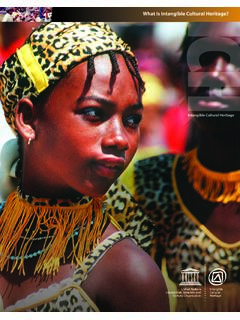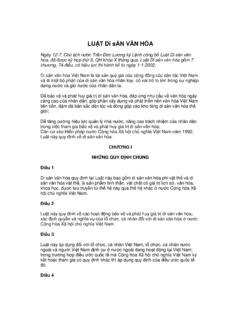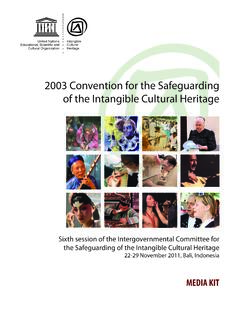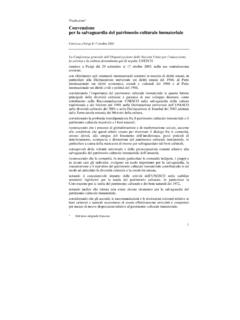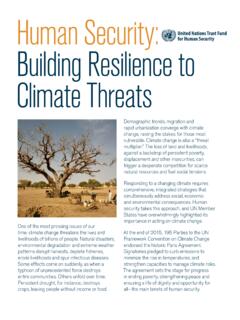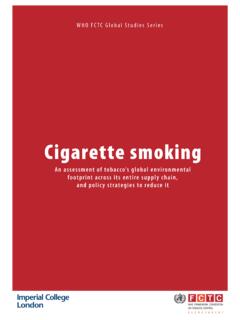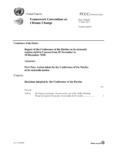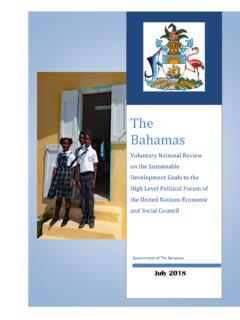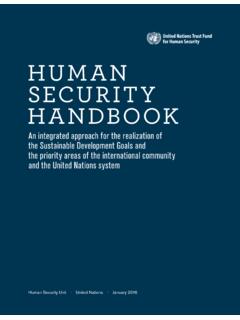Transcription of Intangible cultural heritage and sustainable development; 2015
1 Intangible cultural HeritageIntangible cultural heritage and sustainable Development Viceministerio de 1605/11/2015 16:19 Steven PercivalIntangible cultural heritageand sustainable 105/11/2015 16:18 The Convention for the Safeguarding of the Intangible cultural heritage recognizes the importance of the Intangible cultural heritage as a mainspring of cultural diversity and a guarantee of sustainable development . The 2030 Agenda for sustainable Development constitutes a plan of action addressing the three dimensions economic, social and environmental of sustainable development through 17 sustainable Development Goals as highly interdependent spheres of action that inform development pathways at all levels, and respecting the three fundamental principles of human rights, equality, and sustainability.
2 Intangible cultural heritage can effectively contribute to sustainable development along each of its three dimensions, as well as to the requirement of peace and security as fundamental prerequisites for sustainable development. How can the place of Intangible cultural heritage in sustainable development best be understood so that its contributions can be recognized and fully realized? Vice Ministerio de Cultura Vice Ministerio de CulturaIntangible cultural heritageand sustainable 205/11/2015 16:183 Intangible cultural heritage AND sustainable DEVELOPMENTThe economic, social and environmental dimensions of sustainable development, together with peace and security, are not separate spheres of action, but highly interdependent.
3 Achieving these broad objectives requires holistic approaches to policies, given positive synergies across all dimensions. Intangible cultural heritage can effectively contribute to sustainable development along each of the dimensions, and its safeguarding is therefore essential if communities around the globe are ever to realize the future we want for social developmentInclusive social development cannot be achieved without sustainable food security, quality health care, access to safe water and sanitation, quality education for all, inclusive social protection systems and gender equality.
4 These goals must be underpinned by inclusive governance and the freedom for people to choose their own value societies have constantly developed and adapted their Intangible cultural heritage , including knowledge and practices concerning nature as well as social practices, in order to address fundamental needs and social issues across time and space. Traditional health practices, foodways, water management practices, social gatherings, celebrations and knowledge transmission systems play essential roles for communities to achieve inclusive social cultural heritage is vital to achieving food security.
5 Traditional foodways and local farming, pastoral, fishing, hunting, food-gathering and food preservation systems can contribute greatly to food and nutrition security. Communities have built up considerable traditional knowledge, founded on a comprehensive approach to their specific rural life and environment. Their techniques are based on the use of diverse crops, plants and animals as well as fine-grained knowledge of their land and natural environment in humid, boreal, arid or temperate locations. They have developed foodways as well as production and conservation systems that are diversified and adapted to these locations and environmental changes.
6 A large number of families worldwide depend on agricultural systems that increase soil fertility, provide a varied diet and deliver adequate nutrition and greater health. The continuous strengthening and viability of these systems are crucial to ensuring food sufficiency and security as well as quality nutrition for many communities around the health practices can contribute to well-being and quality health care for all. Communities worldwide have developed a diversity of health-related knowledge and practices, providing effective and affordable therapies, often based on the use of local natural resources.
7 Herbalists for example have been important providers of primary health care to people for millennia. Their traditional knowledge and practices related to medicinal plant use are based on empirical experience in treating patients. In the district of Tanga in Tanzania, for example, healers including herbalists, midwives and traditional mental health specialists have specialized knowledge for treating physical and psychological ailments. Such treatments are affordable and accessible, including in isolated rural areas where other medicine is less readily Food constitutes a central element in celebrations, providing a sense of identity and belonging to the 305/11/2015 16:18 Intangible cultural heritage AND sustainable DEVELOPMENT 4available.
8 It is vital to ensure the recognition of, respect for and enhancement of this therapeutic knowledge and continue its transmission to future generations, particularly where it may be the health care most available to communities. Where other health care services are available, traditional knowledge and practices, deeply ingrained in the socio- cultural fabric with specific spiritual values, are complementary and extend people s practices concerning water management can contribute to equitable access to clean water and sustainable water use, notably in agriculture and other livelihoods.
9 Throughout history, local communities have proven their capacities to shape sustainable water management practices, guided by deeply held beliefs and traditions, and to achieve access to clean water for all. For example, water management systems in San Cristobal de las Casas, Chiapas, Mexico, are based on complex Mayan perceptions of sacred realms and cultural traditions. The Maya believe that humans form an integral part of the water cycle and contribute to the continued renewal of the resource through their natural bodily fluids.
10 Thus, water is considered a communal resource rather than a commodity, and management of the water supply is a responsibility of the whole community. For many communities, such systems constitute the only access to clean water and it is therefore crucial to continue transmitting them to future generations. Elsewhere, traditional systems remain essential as they reduce the communities dependency on external water suppliers and remain more affordable for vulnerable families. Recognition of, and respect for, the diversity of water resource management systems and values and their enhancement and continued transmission are key for the development of sustainable solutions to address water-related environmental and development cultural heritage provides living examples of educational content and method.

